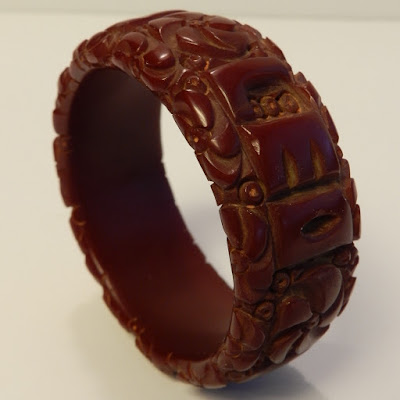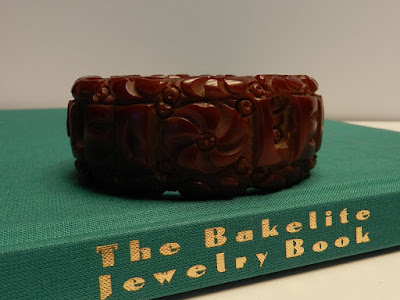It's DEFINITELY Bakelite. It's DEFINITELY old. It's DEFINITELY hand-carved. It's DEFINITELY mine (those who know me know I have a Bakelite sickness weakness). I've been told the color is called Cherry Amber. Beyond that, it's pretty much a mystery! (And right up front, though all thoughts or comments are welcome...this has already been seen by several Bakelite aficionados/dealers, who had their own thoughts on it - possibly an "after-hours" or "home" carve"? All agree it's Bakelite, and it's OLD. It has also been in the hands of an expert who has verified that it is NOT of the Taiwaneese "Fakelite" ilk either, as the prior experts first concurred.)
So, the story on Bakelite goes like this. There have been three major developments in plastics over time - first manufactured in 1855, and further refined in 1868, came Celluloid. Fabulously malleable under heat, but VIOLENTLY flammable and explosive. It saw great use in vanity sets, pretty bracelets set with rhinestones (it's usually ivory in color)...and film. Due to many theater fires, celluloid was eventually replaced by the far less flammable cellulose acetate in photography.
Galalith came next, in 1897. Beautiful colors, and stronger than celluloid, it was also molded by heating. The setback here was it was not strong or moisture resistant, and had a real tendency to warp. Galalith was used for small things like hair combs, buttons, buckles, jewelry, and knitting needles.
Enter Bakelite. In 1907 New York, a Belgian-born chemist named LEO Baekeland invented Bakelite (he also invented Velox). He combined phenolic resin with formaldehyde in the presence of a catalyst and heat, and came up with a plastic that was nonflammable, intractable, and could withstand 1000,000 volts of electricity, intact. It hardened permanently when cured, and would not soften again with heat. It was first used in electrical insulation and radio, telephone and car parts, and later found use in cutlery handles, kitchenware, smoking articles, vanity sets, poker chips, chess pieces, billiard balls, radio cases, and JEWELRY.
Plastic costume jewelry made it's first real appearance in 1918 - mainly celluloid pieces filled with rhinestones and geometric designs. A Shipping Heiress returning from an African trip with armloads of ivory bangles, around 1929, caused the plastics industry to jump on the bandwagon and offer reproductions of these African bangles that had caused such a jewelry riot...1929 also saw the start of THE Crash.
As the Great Depression gradually receded, it was found that many of the rich women could no longer afford the fine jewelry they were accustomed to, and the plastics held a real draw at 20 cents to $3 each (certainly not the prices of today's market). By 1936, 70% of all jewelry sold was cast phenolic resin (or Bakelite)...by 1942 and the start of WWII, Bakelite was needed for defense items, and the jewelry production was done.
There is never a seam to be found in Bakelite, unlike the molded plastic products of today. Each of these bracelets started as an extruded tube of plastic. Slices of varying widths were cut from the tubes, and handed off to skilled artisans who hand carved each piece. The Ace Plastic Novelty Corp. in Brooklyn, and the Moure Family/Alta Novelty Company out of Manhattan seem to be responsible for most of the items found today. The ten member Moure Family turned out some of the more imaginative carved, figural, and geometric jewelry pieces of the late 1930s.
All carving was done by holding the piece of tubing against lathes with high-speed carving tools attached, and the use of hand tools. Extraordinary skills developed, allowing for more and more intricate designs...as these were all hand done, no two pieces are ever exactly alike.
My name is Tanya, and I have a weakness for plastics. I bought this a few weeks back, and it's a mystery. As with anything else that gains popularity, there are new knock-offs being produced "across the ocean" - pretty easily recognizable for what they are supposed to be, but beware - they are out there. However, the designs on those are almost always the popular florals or geometrics.
I bought this from someone who had been collecting since she was 5, thanks to a grandmother...she thought this piece to possibly be a Zodiac reference. The Zodiac was not a "thing" to people living in the late 1930s. Not only that, I know enough to know that the carvers would have added Lions or the astrological sign, instead of flowers. Nope, not astrological.
My own thoughts went immediately to the name carved on it...LEO...as in Leo Baekeland! This piece is pretty incredible - not only is there ONE Leo carved into the side, there are FOUR Leos carved around the sides. There are also four large pinwheel flowers, with an assortment of flowers and "berries" around the top and bottom of the piece. It's a whopper in size - about 1.25" wide; the standard 2.5" inside diameter; and about 3/8" thick. Was this done for him by one of the carvers? Did someone experiment with the carving tools, and do something really out of the ordinary (usually Bakelite has florals or geometric carvings - names such as this were never carved, and are nowhere to be found in any of the numerous books on Bakelite)?
I never intended to purchase it - really! I wrote to her (twice) to let her know my take on it, as opposed to her Astrological description, and that it might "mean" a little more - I was honest with her, as I was just trying to help her out with information. She wasn't biting, and instead, dropped the price drastically, at which point Leo came to live with me (I also have two Leo birthdays in the house, so "whatever works"). NOT astrological, but mine now.
The mystery is in who carved it, and for what purpose or for whom was it carved? Right now, it was carved for ME! Happy early Christmas. It's a mystery.























9 comments:
So happy for you, as I know how happy this makes you! What a treasure <3
Great find!
I'm not sure the Leo astrological is a no. Maybe the carver was creating the bangle for that market and/or as a sales sample trying to tap into the birthday market? There's always the chance the Leo is to honor the creator of bakelite. Is there an industry world's fair around the age of the bracelet? Pushing bakelite booth?
Well, now I know a whole lot more about Bakelite. The bracelet looks like it could be carved wood. I think your take on it sounds reasonable. Perhaps it was made for him as a gift. Or a sample piece.
Amazing find my friend. You get so lucky with that Bakelite stuff!! I just know it was made for Leo of Bakelite fame! I hope we can find someone who knows the real answer!!
There has to be an "Antiques Roadshow" expert Bakelite Appraiser you might be able to contact. This is truly a treasure and how appropriate for it to be yours now for you will take excellent care of it. Bakelite Bliss...
Tanya, you dear lucky girl, what a buy , what a seldom and special piece. Beautiful so very much too, and in that wonderful colour tone, of reddish amber, , wonderful details, and amazingly carved it is, too.
I hope you find the story it bears and that it will stay with you ,always !!
Hugs from Dorthe
Oh, this is really special! I enjoyed reading its history, too. You have a treasure here.
Congrats on your Extremely Special Find! Wow. I can understand ow thrilling it is to acquire this unique piece. ENJOY!
And thank you for the background info. I had no idea the Bakelight pieces were individually made, instead of being molded then polished to remove seams. Fantastic!
Awesome! and I really enjoyed the history
Merry Christmas
Post a Comment